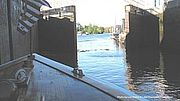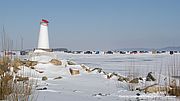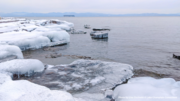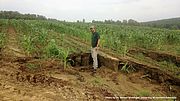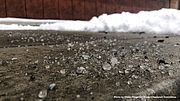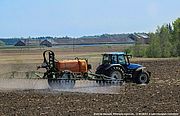The $37.8 billion Water Resources Development Act (WRDA) of 2022 was passed overwhelmingly by the House and Senate and signed into law by President Biden in December. WRDA is biennial legislation that authorizes flood control, navigation, and ecosystem restoration projects for the U.S. Army Corps of Engineers (ACOE). With a $37.8 billion budget, the 2022 version is the largest WRDA in history. In addition to providing authorization for the ACOE to undertake water resources infrastructure projects to address flooding, water transportation, and ecosystem restoration, the bill includes provisions to support underserved communities and address climate change.
WRDA aims to strengthen water restoration, waterway resiliency, invasive species management, and emergency flood protection by channeling more funds and resources to the ACOE for risk management studies and new projects. Key provisions that will help Lake Champlain are outlined below. Read...
Though the days are just starting to lengthen in this new year, winter’s hold on Lake Champlain has really just begun. Lake Champlain does what all water does in cold enough temperatures—it freezes. When record keeping on Lake Champlain freezing began in the 19th century, it was rare for a winter to go by without a complete freeze-over from shore to shore of the lake. This regular freezing created the basis for a seasonal culture of ice-centered activities. Icy activities have been a part of life in the Lake Champlain basin for generations untold, but freezing frequency is expected to plummet due to climate change. Read...
Calling All Paddlers’ – We Want Your Pictures! LCC is seeking boating pictures to enhance our 2023 edition of the Paddlers’ Trail guidebook. If you ventured out on the water with a camera in the past year or two, please consider sharing some photos with us. We are looking for images of human-powered adventures on Lake Champlain and any discoveries made along the way. Scenes of paddling with friends (all wearing PFDs of course), packing your gear, fishing from your boat, taking in a sunrise or sunset, and other visual reflections of water outings are welcome. Read...
While Lake Champlain is not as cold or icy this winter as it has been in winters of yore, it is still not a place for a casual swim at this time of year. This inaccessibility gives the depths of the lake a certain mystery. What is going on underneath the dark surface of Lake Champlain as winter unfolds? How do fish hunker down and survive what seems to be a hostile environment of icy cold water all season long?
Read...
LCC and partners of the Champlain Basin Education Initiative (CBEI), a community of organizations engaged in watershed education, will host Watershed for Every Classroom (WEC), a year-long professional development program for interdisciplinary teams of K-12 teachers in the Lake Champlain Basin.
WEC is like camp for teachers! Participants travel the Basin, visit farms, paddle waterways, explore mountain tops, tour urban areas, and much more! The program helps educators enrich their curricula with local, relevant and engaging topics while addressing national standards and district expectations. Participants network with teachers from around the Basin in Québec, New York and Vermont and meet with Basin scientists, historians, and stewards who work in watershed protection. Read...
Changes in precipitation patterns from climate change is fueling cyanobacteria blooms on multiple fronts. Learn about how soil management can help. Read...
After a warm start to the season, it is finally starting to look--and certainly feel--like winter in the Lake Champlain Basin. To make walking and driving safer in this icy season, state and municipal road crews salt roadways. This practice started in the 1930s, when cars became more commonplace and roads needed winter maintenance. Since then, the annual use of road salts in the US has increased—in the past 45 years, the amount has tripled—to a yearly estimated total of 25 million metric tons.
All of this salt has to go somewhere. When in contact with the water, salt dissolves into its ion building blocks, the most common of which are sodium and chloride. The now salty water first washes off roads, stoops, parking lots, and sidewalks, and it can kill adjacent vegetation quickly, as these species are rarely adapted to high salinity. Salty water then either seeps into groundwater or flows through waterways, winding up in larger reservoirs like Lake Champlain. Chloride concentrations in Lake Champlain and its tributaries have been steadily rising for the past several decades. Read...
In the depths of Lake Champlain, an eel-like creature slithers among the rocks, hunting for a foraged fish dinner. This is no sinister cousin of Champ—this is the burbot (Lota lota), one of Lake Champlain’s only deep-water predator fish (the other one is lake trout). Burbot have a unique look, with small scales forming patterns of blotched green, brown, yellow, and black, all making up their particularly slimy skin. Perhaps their most distinct feature is the single “barbell” protruding from under their chin—think of a long, narrow goatee made of scales rather than hair. They also have large, wide-set, tubular nostrils that protrude from the front of their face, resembling catfish. Read...
In the fall of 2022, the Lake Champlain Committee, Vermont Natural Resources Council (VNRC), Shelburne Farms and a host of environmental and conservation organizations collaborated on a tribute to Senator Patrick Leahy in recognition of his unwavering support of communities and the environment during his decades-long tenure in public service. The event was held at Shelburne Farms, overlooking the lake he has done so much to protect and attended by over 500 people. Throughout his career in the US Senate, Patrick Leahy has been an unfailing champion for our region’s—and the nation’s—air, water, and land, and for public health. From the Conte National Wildlife Refuge, across the Green Mountain National Forest, to Lake Champlain, his dedication to safeguarding and investing in natural resources has improved our lives.
“Senator Leahy has led work to protect and restore Lake Champlain for four decades through both authorizing and appropriating legislation” stated LCC Executive Director Lori Fisher. “He has left a legacy that will be remembered and revered for generations to come.” Read...
Sincere thanks to our wonderful team of 2022 cyanobacteria monitors and partner organizations. Monitors faithfully checked Lake Champlain and inland lake locations in wind, rain, sleet, and sun during a 20-week long monitoring season and filed over 2,500 reports on water conditions.
Please join us for the 2023 season if you have some free time every week during the summer and fall and want to give back to a waterbody you love. You’ll receive training in the spring, a cool t-shirt and hat, and support throughout the monitoring season. By volunteering you’ll gather important data to aid research, keep community members apprised of water conditions, and help strengthen and expand the monitoring program. We are looking for monitors for both Lake Champlain and inland lakes. Read...

